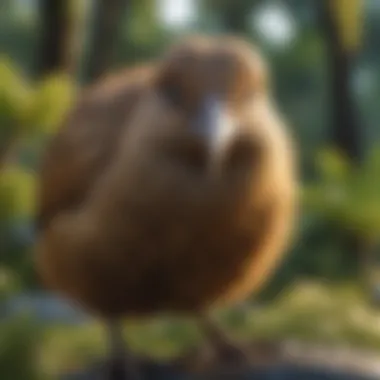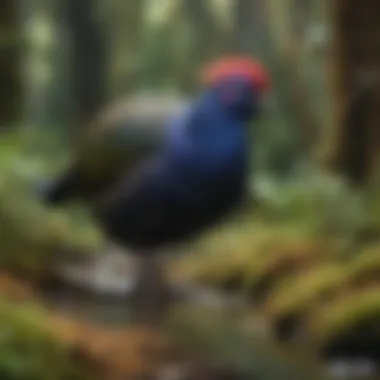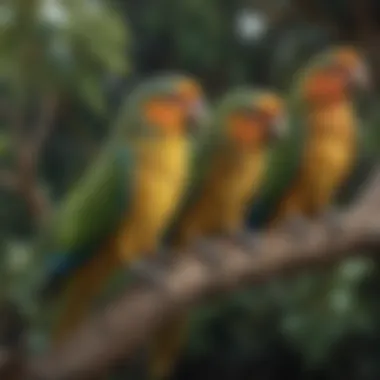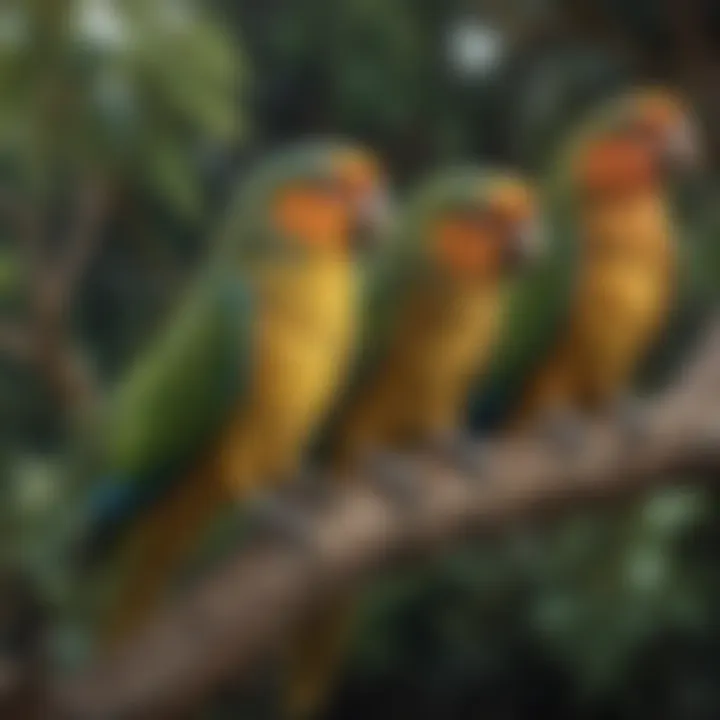Explore the Fascinating Birds of New Zealand


Intro
New Zealand is a treasure trove of biodiversity, particularly when it comes to its bird population. The country's unique ecosystems and geographical isolation have fostered the development of a remarkable array of avian species, many of which are found nowhere else on Earth. This guide aims to illuminate the intricate world of New Zealand's birds, shedding light on their fascinating behaviors, habitats, and the ongoing conservation efforts to protect them. As bird enthusiasts and conservationists delve into this exploration, they will find both the beauty and the challenges faced by these incredible creatures.
Birds in New Zealand are not just mere highlight of the landscape; they are intricate components of the ecosystem. Their roles extend beyond just singing sweet tunes or showcasing vibrant plumage. Many species serve essential functions, such as seed dispersal and pollination, contributing to the health of their respective habitats. Therefore, understanding New Zealand's birds is pivotal, not just for enthusiasts, but for everyone invested in the region's ecological balance.
To fully appreciate and protect these avian wonders, one must understand a few key aspects: the unique characteristics of different species, their specific habitats, and the conservation measures in place to sustain them. This guide is structured to provide a roadmap, leading readers through various crucial topics, such as detailed descriptions of notable bird species, conservation status, and anticipated challenges.
By navigating this comprehensive guide, readers will gain insights that are both valuable and practical, enhancing their understanding of New Zealand's avifauna and inspiring action towards its preservation.
Intro to New Zealand Birds
New Zealand is a unique paradise for bird enthusiasts, offering an avian landscape that's incredibly rich and diverse. Nestled in the southwest Pacific, this island nation is home to a plethora of bird species that have evolved in isolation over millions of years. The importance of understanding New Zealand's avifauna lies not only in the enjoyment of birdwatching but also in recognizing the ecological roles these birds play. Knowing about them can unlock a deeper appreciation for biodiversity and conservation efforts as well.
Geographical Overview
When one thinks of New Zealand, images of lush green hills, rugged coastlines, and a land that feels almost primordial may come to mind. This rich topography contributes to the variety of habitats that birds call home.
From the towering mountains of the Southern Alps to the sprawling coastal wetlands and dense rainforests, each of these ecosystems offers different opportunities and challenges for bird species. Unique habitats foster the development of distinct ecological niches where birds can thrive. For instance:
- Alpine Zones: Home to the stunning Kea, these high-altitude areas provide niches filled with rugged beauty and harsh weather.
- Forested Regions: Areas like Fiordland house species such as theFantail, which flits through the underbrush, while the Hihi thrives in the canopy's rich vegetation.
- Wetlands: The Takahe inhabits these environments, where it finds the water plants critical to its diet.
By understanding the geographical context, one can appreciate how the land shapes the lives of birds, determining everything from their feeding habits to mating behaviors.
Significance of Avian Diversity
The richness of bird diversity in New Zealand is not just a matter of numbers; it's about the interconnectedness of ecosystems and cultures. Each species offers a glimpse into the functioning of its environment. For example, the iconic Kiwi, a flightless bird, is more than just a national symbol—it represents the intricate web between flora and fauna.
Understanding avian diversity includes recognizing:
- Ecological Roles: Birds contribute to pollination, seed dispersion, and pest control, thus maintaining the balance in their habitat.
- Cultural Impact: Many species hold significant places in local Māori traditions, symbolizing aspects of spirituality and identity.
- Conservation Awareness: The decline of certain species like the native Kākāpō highlights the urgent need and continuing efforts toward conservation.
In sum, the avian diversity of New Zealand is a fascinating tapestry woven from environmental, cultural, and conservation threads. The loss of a single species can ripple through ecosystems, making it crucial to understand and appreciate this natural heritage.
Key Bird Species of New Zealand
The birds of New Zealand are more than just colorful inhabitants of the skies; they are integral to the identity and ecological fabric of the region. Each species carries a story, forged in a landscape that has remained relatively isolated for millions of years. This section serves to illuminate the important bird species of New Zealand, showcasing their distinctive traits, habitats, and behaviors. Bird enthusiasts and conservationists alike will gain a deeper understanding of these creatures, which are not only vital for their ecosystems but also for the cultural heritage of the country.
Kea (Nestor notabilis)
Physical Characteristics
Kea are striking birds, distinguishable by their olive-green plumage and bright orange underwings. These features play a role in their habitat, camouflaging them among the lush mountain trees and rocky trails where they thrive. One of the notable aspects is their size; they are the largest parrots in New Zealand and possess strong, curved bills ideal for their omnivorous diet. This physical attribute makes them adept at foraging, allowing them to extract food from tough surfaces, which is a major advantage in their natural habitat.
Behavioral Traits
Kea are curious and intelligent creatures, often seen interacting with both their environment and humans. Their playfulness is perhaps their most charming trait, as they are known for manipulating objects and solving problems. This behavior not only entertains bird watchers but is a sign of their high adaptability, often leading to both benefits and challenges in their interactions with human-influenced landscapes. Their trustful nature towards people can occasionally put them in risky situations, making them a subject of concern and interest in terms of conservation efforts.
Habitat and Distribution
These remarkable birds prefer the alpine regions of the South Island, often occupying mountainous terrains. Their adaptability to various environments showcases their resilience but also raises concerns as habitat fragmentation poses a threat to their survival. Protection of their habitat isn't just about preserving these landscapes; it's also crucial for supporting the delicate balance of the ecosystem they inhabit.
Takahe (Porphyrio hochstetteri)
Conservation Status
The Takahe, once thought extinct, symbolizes New Zealand's restoration efforts in wildlife conservation. Their population has made a comeback due to rigorous conservation programs. The challenges they face, including habitat loss and the impact of invasive species, highlight the ongoing need for protective measures. Their recovery serves as an important case study for conservationists worldwide, demonstrating the impact of community involvement and rigorous management.
Feeding Habits
Takahe have a herbivorous diet primarily consisting of grasses, leaves, and seeds. Their unique feeding habits shape the vegetation dynamics in their habitats, thus playing a critical role in the ecosystem. However, their reliance on specific habitats for food makes them vulnerable to changes in their environment, emphasizing the importance of habitat preservation in supporting their feeding needs.


Breeding Patterns
The Takahe's breeding patterns are intriguing. They typically form long-term monogamous pairs, which is relatively rare in the bird world. This bond is essential for their breeding success, ensuring that both parents share responsibilities in rearing their young. The specifics of their breeding seasons can vary, influenced by environmental conditions, making their reproductive strategy highly adaptable.
Kiwi (Apteryx spp.)
Unique Adaptations
Kiwis are flightless birds with unique adaptations suited to their nocturnal lifestyle. Their long beaks with sensitive nostrils enable them to forage effectively in the ground for insects and worms. These adaptations are a testament to evolution, showing how species can fine-tune themselves to thrive in specific ecological niches. Unfortunately, their unique features also make them particularly vulnerable to predators.
Threats to Survival
Kiwis face numerous challenges to their survival, chiefly from introduced species such as rats, stoats, and cats. The encroachment of human development on their habitats also adds to their plight. Efforts to bring awareness to these threats are crucial, as public involvement is a key element in conservation strategies that aim to enhance the prospects of this iconic species.
Cultural Importance
Kiwis hold a vital place in New Zealand's culture, symbolizing national identity. They are often featured in stories and art, bridging the gap between nature and tradition. This cultural significance amplifies the importance of their conservation, as protecting the kiwi is akin to preserving New Zealand's heritage itself.
Fantail (Rhipidura fuliginosa)
Song and Calls
The Fantail is celebrated for its delightful chirps and complex songs, often likened to a friendly conversation. Their melodic calls are not only a pleasant experience for bird watchers but also play a role in their social interactions and territory establishment. These vocal traits encourage engagement, making the Fantail a favorite among both amateur and experienced birders.
Feeding Behavior
Fantails have a unique feeding behavior known as "gawking," which involves fluttering about to catch insects mid-air. This agility is not just fascinating to observe; it's also a critical survival strategy that aids in their insectivorous diet. Observing their feeding techniques can offer insights into their adaptive strategies within changing environments.
Breeding Biology
The breeding biology of Fantails involves intricate nest-building skills, as they often use spider silk and plant materials to construct their nests. They typically lay a clutch of eggs, and both sexes participate in raising their young. Their nurturing behaviors reflect a strong commitment to their offspring, enhancing the survival of the species in the wild.
Hihi (Notiomystis cincta)
Habitat Preferences
Hihi prefer subtropical and temperate forests, where they can thrive among the nectar-producing plants. Their habitat choices influence their distribution and population health, making the preservation of these areas vital for their sustainability. The specific conditions of their preferred environments nurture their feeding habits and social behaviors.
Restoration Efforts
Hihi recovery efforts have faced numerous hurdles, from habitat destruction to predation pressures. Conservation programs focus on habitat restoration and translocation initiatives to increase their population size. Success stories of Hihi serve as exemplars of how targeted conservation practices can result in remarkable recoveries within endangered species.
Social Behaviors
The social structure of Hihi is fascinating, reflecting complex interactions within their groups. They communicate through a variety of calls, supporting their cohesion as a species. This social behavior enriches their ecological roles, as they often interact with other species, helping to maintain the balance of their forest homes.
The diverse avian community of New Zealand plays a crucial role in its ecological systems. Understanding these unique species helps foster greater appreciation and encourages protection efforts vital for their future.
Conservation and Protection of New Zealand Birds
Conservation and protection of New Zealand birds isn’t just a matter of keeping things pretty in the great outdoors. It’s a crucial aspect of maintaining biodiversity and ecological balance in the region. The unique avian population of New Zealand faces many challenges that, if not addressed, could lead to dire consequences not just for the birds, but for the environment as a whole. From invasive species to climate change, understanding these threats allows us to appreciate the significance of concerted conservation efforts.
In the absence of these efforts, New Zealand's birds could continue to vanish, with impacts rippling through local ecosystems and even affecting human communities. Moreover, the powerful connection between culture and wildlife in New Zealand emphasizes why protecting these birds is not merely an environmental issue; it’s tightly interwoven with the identity and heritage of the nation.
Overview of Threats
Invasive Species
Invasive species are like unwelcome guests crashing a party, disrupting the natural interactions between native flora and fauna. In New Zealand, these intruders can be anything from rats to stoats, forming tight predatory relationships with vulnerable bird species. Over the years, these species have contributed significantly to the decline of native birds, preying on their eggs, chicks, and sometimes even adults.
While invasives can sometimes generate curiosity and interest among wildlife enthusiasts, their impacts generally skew negative. They overshadow indigenous species that have evolved over thousands of years, leading to a decrease in biodiversity. Supporting measures to control or eradicate these invasive species is paramount to safeguard New Zealand’s unique avian treasures while preserving the fragile ecosystems they inhabit.


Habitat Loss
The steady decline of natural habitats stands as one of the gravest threats to New Zealand's birds. Deforestation for agriculture, urban expansion, and industrialization has turned once-flourishing ecosystems into barren landscapes. Habitat loss not only poses immediate risks to birds that rely on specific environments for foraging and nesting but also disrupts the intricate web of relationships that sustains ecosystems.
One prime example is the loss of native forests, where many endemic bird species thrive. The advantages of restoring these areas are evident; healthier ecosystems contribute to more stable populations of birds and other wildlife, reestablishing natural balance while benefiting human life through improved air and water quality.
Climate Change
Climate change introduces another layer of complexity, affecting bird migration patterns, breeding seasons, and food availability. As temperatures rise and weather becomes increasingly unpredictable, the consequences trickle down the food chain. Some birds, like the rare Kākāpō, may struggle to cope with the shifting climate, impacting their survival.
It’s not just the birds that pay the price; entire ecosystems are at risk. As habitats change, the delicate relationships that birds have with other species can unravel. Addressing climate change through sustainable practices, conservation initiatives, and community awareness becomes essential to protect New Zealand’s avifauna for generations to come.
Conservation Efforts
Government Initiatives
Government initiatives play a pivotal role in the conservation landscape of New Zealand birds. Legislative frameworks like the Resource Management Act and the Biodiversity Strategy create a robust foundation for protecting native species. These initiatives often focus on habitat protection, controlling invasive species, and promoting research to monitor bird populations.
The crucial characteristic of these initiatives is their comprehensive approach, which brings together a multitude of stakeholders—government bodies, scientists, and local communities—to forge effective conservation strategies. While it's not a smooth path—budget constraints and political shifts can pose difficulties—the core benefits lie in collaborative action, leading to more holistic outcomes.
Community Involvement
Community involvement emerges as a cornerstone of successful conservation efforts. Local groups often mobilize for initiatives like habitat restoration, bird monitoring, and educational campaigns to raise awareness about the fragile state of bird populations. It’s heartening to see communities embrace stewardship roles, fostering a sense of ownership and encouraging eco-friendly practices.
The interaction between these groups and government initiatives shines a light on the grassroots movements that can lead to impactful change. More than just individual actions, community involvement helps build resilient networks that contribute to sustained conservation outcomes over time, though challenges like funding and volunteer engagement can arise.
Protected Areas
Establishing protected areas is one method to offer refuge to New Zealand's vulnerable bird species. Sites like Fiordland National Park and Rimutaka Range have been designated specifically to safeguard habitats and ensure native birds have safe spaces to thrive. These areas are critical, as they serve as reservoirs of biodiversity, offering protection against human activities and environmental threats.
Key features of protected areas include their ability to host diverse ecosystems and their role in facilitating scientific research that informs future conservation practices. Yet, challenges remain; limited resources for management and potential conflicts with land-use priorities can impede the effectiveness of these areas. Thus, ongoing commitment and collaboration are needed to maximize the advantages of these safeguarded spaces while ensuring they continue to play a vital role in the protection of New Zealand's avian diversity.
Birdwatching in New Zealand
Birdwatching in New Zealand is more than just a leisurely activity; it's an exploration into the heart of a unique ecosystem. The islands serve as a sanctuary for numerous endemic species, making it a paradise for bird enthusiasts. By observing these remarkable creatures in their natural habitats, people can gain insights into conservation needs, biodiversity, and the intricate web of ecological relationships. Birdwatching also encourages an appreciation of New Zealand’s rich cultural heritage, as many avian species hold significance in Maori traditions and stories.
Best Locations for Birdwatching
National Parks
National parks in New Zealand, such as Fiordland and Abel Tasman, present a treasure trove for birdwatchers. These protected areas boast pristine environments that serve as habitats for a variety of birds, including the endangered Kaka and the elusive Kiwi. The beauty of national parks lies not only in their stunning landscapes but also in the commitment to preserving native flora and fauna.
Being surrounded by untouched nature provides a peaceful backdrop, allowing for a tranquil birdwatching experience. One unique feature of these parks is their vast and diverse ecosystems, from towering mountains to lush rainforests. These varied landscapes offer different birdwatching opportunities, catering to both seasoned watchers and newcomers. However, accessibility can sometimes be a concern, as remote areas may require a bit of trekking.
Reserves
Bird reserves like the Okarito Kiwi Sanctuary highlight the importance of preserving specific habitats for vulnerable species. These reserves serve as a safe haven where birds can thrive away from urban disturbances. The quiet, secluded nature of reserves makes them ideal for spotting rare and native birds, including the Takahe and various shorebirds.
Reserves often emphasize conservation efforts, and many visitors will find valuable educational information about local bird species and their needs. Moreover, the unique feature of a reserve is its focus on fostering a symbiotic relationship between wildlife and local communities. However, because reserves are often smaller than national parks, they may have limited species diversity.
Urban Areas
Surprisingly, urban areas in New Zealand can also be great for birdwatching. Cities like Wellington and Auckland offer parks and green spaces where a mix of both native and introduced species can be observed. Birdwatchers can find opportunities to see urban adaptations of birdlife, such as the sparky Silvereyes scuttling through gardens.
A key characteristic of urban birdwatching is the accessibility it offers. Many parks are just a stone's throw away from bustling city life, allowing for a quick birdwatching escape. The unique feature of these areas is their adaptability, as birds like the Red-billed Gull have become quite comfortable in urban settings. However, challenges such as noise pollution and limited natural habitats can sometimes affect bird behavior and sightings.
Tips for Birdwatchers
Optimal Times
Timing can make all the difference when birdwatching in New Zealand. Early mornings, just around dawn, are generally the most fruitful periods for spotting birds as they are often more active. Many species sing at this time, facilitating identification. Additionally, many birdwatchers prefer late afternoons for similar reasons.


The periodic nature of bird behavior ties closely to feeding and nesting, so being aware of these cycles can enhance the experience. It's effective to note seasonal changes; for instance, migration periods can lead to a surge in species diversity.
Equipment Recommendations
When venturing out, having the right equipment can elevate the birdwatching experience. Binoculars are essential, and choosing a pair with a good magnification can make distant birds observable. A field guide specific to New Zealand's birds is also highly beneficial, allowing quick identification on the spot.
A notebook can be a handy tool to jot down observations and sketches, adding a personal touch to the birdwatching journey. Moreover, some enthusiasts utilize apps for bird calls, which can help identify birds by sound. Selecting lightweight gear enhances mobility, especially when moving through different terrains.
Ethical Birdwatching Practices
Adhering to ethical birdwatching practices is necessary to minimize disturbances to wildlife. Keeping a respectful distance from nests or active feeding grounds is vital to prevent stress on birds. Responsible birdwatchers prioritize silence and avoid startling birds, especially species that are more skittish.
Additionally, staying on marked paths while observing prevents unintentional damage to habitats. Awareness of local guidelines regarding wildlife interactions can enrich the experience. A notable effort is participating in citizen science projects, which helps contribute to conservation initiatives while enjoying the beauty of New Zealand avifauna.
Birdwatching is not just about seeing birds; it's also about connecting with nature and engaging in meaningful conservation efforts. By practicing mindful birdwatching, enthusiasts can play a part in protecting these incredible species.
Cultural Perspectives on New Zealand Birds
Understanding the cultural perspectives on New Zealand birds opens up a fascinating window into how intertwined avian life is with the country's heritage. The connections between birds and New Zealand's heritage can tell us a lot about the values and traditions of its people, particularly the Maori. Additionally, exploring the modern representations of these birds illustrates their ongoing influence and significance today. In this article section, we'll analyze how historical traditions, folktales, and contemporary art embody the essence of New Zealand's avifauna.
Historical Significance
Maori Traditions
Maori traditions revolve significantly around the avifauna that inhabits New Zealand. Birds like the Kiwi hold a special place in Maori lore and serve as identifiers of cultural identity. The Maori reference various species in their songs, chants (hangi), and tattoo art, which reflects a deep respect for these creatures.
One key characteristic of Maori traditions is their oral history, where the stories often include birds as pivotal characters. For example, the legendary Tāne Mahuta, the god of forests and birds, showcases the importance of avian life in Maori cosmology. This culturally rich narrative weaves natural elements with the spiritual realm, showing how birds are considered messengers between people and the gods.
Moreover, these traditions help us recognize the significance of birds in strengthening community bonds. They often revolve around shared practices in hunting and rituals that involve birds, making their presence both a cultural and communal asset. The unique feature of Maori traditions is their capacity to educate younger generations about the ecological significance and identity linked to New Zealand's wildlife. However, one disadvantage might be that these customs could be vulnerable to fading global influences.
Folklore and Mythology
The rich tapestry of New Zealand's folklore and mythology also underscores the avian narrative. Birds often symbolize various traits ranging from resilience to companionship, playing roles in stories that have captivated generations. One notable tale is of the Kea, known for its cleverness, often seen as a trickster. Such tales reveal not just the behaviors of these birds, but also reflect human qualities we aspire to or caution against.
A vital characteristic of these myths is their ability to engage listeners of all ages. They have a way of imparting lessons about nature and ethics, making them timeless choices for storytelling in contemporary settings. The unique feature of these stories is their geographical specificity, connecting listeners personally to the land and its environment. On the flip side, they may sometimes perpetuate misconceptions about bird behavior, mistaking mythology for reality.
Modern Representation
Art and Literature
Art and literature in New Zealand prominently feature birds, serving as both inspiration and subject matter. Artists like Rita Angus and writers like Patricia Grace have integrated avian imagery and symbolism into their works, fostering a deeper appreciation for the natural world. Their contributions highlight not just the aesthetic value of birds, but also invoke discussions about national identity and environmental concerns.
One significant aspect is the power these works have in raising awareness about conservation issues. The portrayal of endangered species in both literature and visual art can evoke emotional responses, demanding action from society. The unique characteristic of modern representation is its ability to adapt traditional motifs for contemporary audiences. However, a challenge remains in ensuring that these representations do not stray too far from the facts of avian life and conservation needs.
Symbolisms in National Identity
The role of birds in shaping New Zealand's national identity is substantial. National symbols like the Kiwi have become a universal representation of the country's uniqueness. The Kiwi's flightless nature and distinct appearance communicate resilience, and this avian emblem is seen everywhere from logos to tourism campaigns.
One key element of this symbolism is its ability to unite people from diverse backgrounds under a shared identity. The uniqueness of the Kiwi, both in terms of biology and cultural representation, exemplifies the broader themes of diversity and pride among New Zealanders. However, the challenge is to maintain this symbolism's relevancy amid global influences and changing perceptions of culture.
Closure and Future Perspectives
As we look to the future, the landscape of New Zealand's avian population faces a myriad of challenges. It’s crucial to recognize the intricate balance that exists between human activity and the natural habitats of these unique birds. New Zealand has a rich tapestry of avifauna, with species that are found nowhere else on earth, and it is our collective responsibility to safeguard this heritage.
Summary of Key Points
Throughout this guide, we’ve explored various aspects of New Zealand birds, from the iconic Kiwi to the graceful Takahe. Here are some crucial points to recall:
- Diversity and Uniqueness: New Zealand's isolation has given rise to numerous endemic species, each playing a vital role within its ecosystem.
- Conservation Efforts: Increasing awareness and community involvement are key to protecting these birds from threats such as habitat destruction and invasive species.
- Cultural Importance: The connection between the native people and these birds underscores their significance in New Zealand's identity and cultural narratives.
The Importance of Continued Conservation
Preserving New Zealand's birds is not just about saving species; it’s about maintaining the health of entire ecosystems. The ripple effects of losing a single species can have profound consequences, not just locally, but globally. Consider this: The Hihi, or Stitchbird, serves as an indicator of ecosystem health. When its populations decline, it signifies broader environmental issues.
Involving Communities and Individuals: As seen in various conservation programs, community involvement can enhance awareness and encourage responsible behaviors towards nature. Citizen science projects, where locals assist in tracking bird populations, provide invaluable data and foster a deepened appreciation for these creatures.
Adapting to Change: Climate change poses an ever-growing threat, impacting habitats and food sources. The ability to adapt conservation strategies based on ongoing research and results will be pivotal. Engaging policymakers, scientists, and the public in these discussions can propel both local and national efforts toward a sustainable future.
Let this guide stand as a reminder of what we must strive to protect while prompting all of us to act in the interest of those winged inhabitants that enrich our lives and culture.















